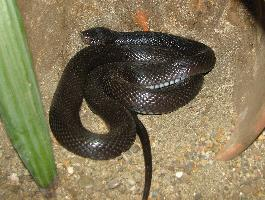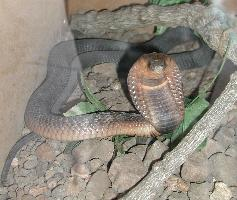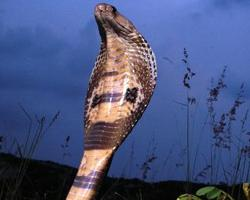
Descrierea animalului
The Desert Cobra, scientifically known as Walterinnesia aegyptia, is a fascinating species of venomous snake native to the arid and semi-arid regions of the Middle East and parts of Africa. This elusive serpent is an integral part of the desert ecosystem, exhibiting unique adaptations that enable it to thrive in one of the most challenging habitats on Earth.Adult Desert Cobras typically reach lengths of about 1 to 1.5 meters, although some individuals may grow larger. They possess a sleek, robust body that is predominantly black or dark brown, allowing them to absorb heat quickly and blend seamlessly into their surroundings. This coloration plays a crucial role in their survival, aiding in both thermoregulation and camouflage.
One of the most distinctive features of the Desert Cobra is its head, which is slightly distinct from its neck, giving it a characteristic cobra appearance. However, unlike some of its relatives, the Desert Cobra does not display the iconic hood. Its eyes are relatively small with round pupils, adapted to the bright desert environment.
The Desert Cobra is a nocturnal predator, primarily active during the cooler night hours when it hunts for its prey. Its diet consists mainly of small mammals, birds, and occasionally other reptiles. It employs a sit-and-wait strategy, relying on its camouflage to ambush unsuspecting prey. Once a target is within reach, the cobra strikes quickly, injecting a potent neurotoxic venom that immobilizes the prey almost instantly. This venom is highly effective, making the Desert Cobra a formidable predator in its natural habitat.
Reproduction in Walterinnesia aegyptia is oviparous, meaning the female lays eggs. The breeding season typically occurs in the spring, with females laying clutches of eggs that they leave to incubate in the warm desert sands. The eggs hatch after a few months, with the young cobras being relatively independent from birth, equipped with venom and hunting instincts to fend for themselves.
The Desert Cobra's venom is not only significant for its predatory habits but also because it has been the subject of medical research. Scientists study its components for potential therapeutic applications, including the development of antivenoms and other drugs.
Despite its venomous nature, the Desert Cobra is generally elusive and avoids human contact. However, encroachments into its natural habitat and other human activities pose threats to its population. While not currently listed as endangered, the species faces challenges from habitat destruction, persecution, and the illegal pet trade.
In conclusion, the Desert Cobra (Walterinnesia aegyptia) is a remarkable creature that embodies the essence of survival in the desert. Its adaptations to a life in harsh conditions, its role as a predator, and the scientific interest in its venom make it a significant species in the biodiversity of desert ecosystems. Conservation efforts are crucial to ensure that this intriguing serpent continues to play its role in the natural world.
Animale similare
Fotografii noi cu animale
Top 10 animale
- Dolphin gull (Leucophaeus scoresbii)
- Diana monkey (Cercopithecus diana)
- Moustached guenon (Cercopithecus cephus)
- Galápagos tortoise (Geochelone nigra complex)
- Stone loach (Barbatula barbatula)
- Japanese macaque (Macaca fuscata)
- Greek tortoise (Testudo graeca)
- Russian tortoise (Testudo horsfieldii)
- Common flying dragon (Draco volans)
- Galápagos penguin (Spheniscus mendiculus)


